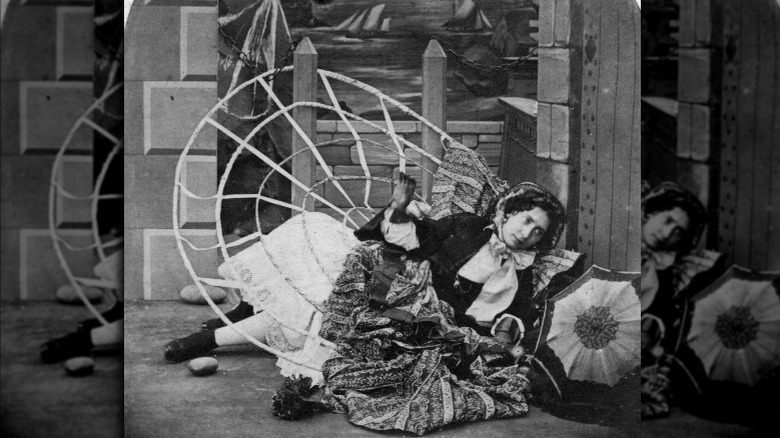The Victorian Era Fashion Trend That Killed Thousands
For some fashion-forward women, sacrificing a little bit of comfort is a small price to pay to look good while wearing the latest trends. For instance, corsets were popular in the 1800s because they gave women an hourglass figure, despite constricting breathing and being uncomfortable to wear for long periods of time. Another Victorian-era fashion trend was the crinoline, a type of petticoat that goes under a dress to achieve the massive volume on skirts worn by women of that time.
In the early 1800s, big skirts were the trend. To achieve the look, several layers of petticoats were worn underneath dresses, per The Vintage News. However, it was a significant discomfort for women as the fabrics were heavy and movements were limited. The crinoline was invented as a solution that weighed significantly less than wearing numerous petticoats and allowed for a little more freedom while moving. The word "crinoline" originated from the French words "crin" and "lin," which mean horsehair and linen, respectively, as the first crinolines were made from the two materials.
Later versions of the crinoline consisted of steel and whale bones, creating a cage-like structure to hold the voluminous shape of a skirt, per Met Museum. The crinoline was so popular that the word "crinolinemania" was coined to describe women obsessed with using the fashion accessory.
The risks of wearing a crinoline
Although crinolines were lighter to wear than petticoats, they came with their own downsides. For example, they were still uncomfortable to wear, and women had to be extra careful when sitting down, as the rigid steel or bones of the crinolines could tear the fabric of their dresses. It was also impossible to go through narrow halls and doorways, as crinolines came with a circumference of at least a few feet to 15 feet at most (via Wonderful Engineering). Furthermore, strong winds were often culprits when crinoline-wearing women went toppling down and the rigid cage underneath their dresses left them exposed for everyone to see. Although these risks might not seem too severe, there were also some fairly serious consequences attached to these pieces of fashion. In fact, over the years, thousands of women lost their lives to crinolines, making them literal fashion victims.
Deaths from crinolines
Crinolines were made of various materials, such as gauze, cotton muslin, and bobbinet — all of which are extremely flammable. An incident was reported in 1863 on "The Times" wherein Margaret Davey, a 14-year-old maid, died of severe burns when her dress caught fire while getting spoons on the mantelpiece near the fireplace (via History Daily). In another incident, 16-year-old Emma Musson died after a piece of burning coal ignited her dress. The crinoline's flammable materials combined with mounds of fabric to hasten the burning, and women couldn't get out of them in time as the crinoline was secured to their waists with a belt.
There were other fatalities reported that didn't involve fire, and the incidents were just as tragic. One report mentioned the death of Ann Rollinson, who died of the injuries she sustained after her crinoline got caught in a machine at her workplace, according to Wonderful Engineering. Tragically, experts say that between the 1850s and 1860s, 3,000 women died of fire-related incidents while wearing the crinoline. In an 1864 report, almost 40,000 women all over the world had perished since the fashion fad started.


